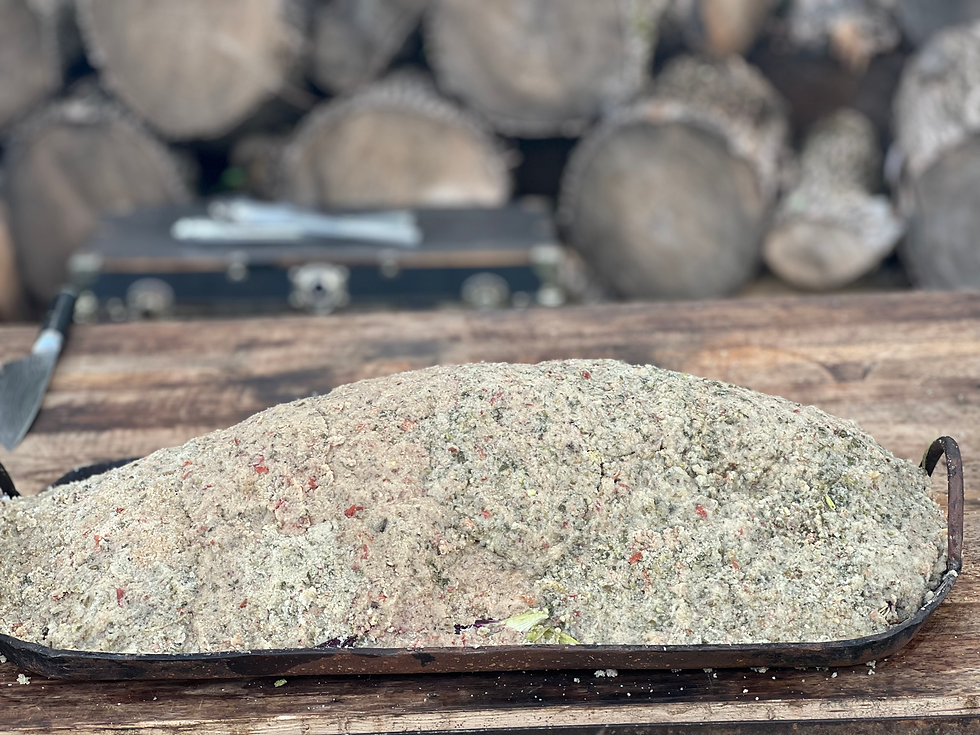Crystals & Coals: The Science and Art of Salt Roasting
- James

- Oct 3, 2023
- 3 min read

The Origins of Salt: A Pillar of Civilization
Salt's journey from ancient sea beds to our dinner tables is a tale as old as civilization itself, and it's a story I love sharing with my guests at Heirloom Fire. Once a valuable commodity that shaped trade routes and even served as currency, salt has evolved into a culinary essential that transcends its humble origins. It's not just about seasoning; it's about elevating a dish to an experience.

The Evolution of Salt in Cooking: From Preservation to Perfection
Salt has come a long way from its original role as a simple preservative. Today, it's a culinary essential that chefs and home cooks use to elevate flavors and textures. One technique that has gained significant attention is salt-roasted cooking. This method utilizes salt as a cooking medium, locking in moisture and enhancing taste to a level that's hard to achieve through other means.
Salt-roasted cooking is an ancient technique that has stood the test of time. By encasing ingredients in a salt crust before roasting, you seal in natural juices, resulting in incredibly tender and flavorful dishes. This method is versatile, suitable for a variety of meats, fish, and even vegetables.

Choosing the Right Salt: The Foundation of Flavor
The type of salt you choose can make or break your salt-roasted dish. Coarse sea salt is the preferred choice for most chefs due to its larger crystals, which form a sturdy crust that allows for even cooking. At Heirloom Fire, we will take this method to the next level and create flavored salts to encase items. Flavored salt not only imparts a unique flavor, it yet another way that we cut down on waste. Great surplus-friendly items to incorporate into salts are onion skins, carrot trimmings, roasted beet skins, zest from juicing lemons and herbs stems.

Preparation Steps: Setting the Stage for Culinary Success
Before you embark on your salt-roasted cooking adventure, there are a few key steps to take. Preheat your oven and prepare your ingredients. Coat your chosen item—whether it's meat, fish, or vegetables—in a generous layer of salt. For an added layer of complexity, consider incorporating whole onions, herbs and lemons (especially when roasting fish).

Cooking Time and Temperature: The Science of Perfection
The cooking time and temperature can vary depending on the ingredient you're using. However, a general guideline is to roast at a high temperature, usually around 450°F (232°C), until the salt crust hardens and turns a golden brown. This ensures that your dish is cooked to perfection. When you are close to your end cook time, use a pointed instant read thermometer to gently burrow through the salt and into the protein. You'll want to remove the protein from the oven hen you are about 10 degrees under your desired temperature as the salt will hold the high heat for some time and allow your protein to gently come up to temperature.

The Benefits of Salt-Roasted Cooking: Why It's Worth the Hype
Salt-roasted cooking offers a plethora of advantages. First and foremost, it locks in moisture, ensuring your dish is juicy and tender. Additionally, the salt naturally enhances the flavor, reducing the need for extra seasoning. It's a straightforward technique that yields extraordinary results, making it a go-to method for both novice cooks and culinary experts. Additionally, you can collect your salt after breaking open your dinner and store it in the freezer to use again. Over time, you'll develop something of a "Master Salt" that has the many layers of what you've used it to cook with.

Salt-roasted cooking is not just a culinary trend; it's an art form with deep historical roots. By understanding its origins and mastering its techniques, you can elevate your cooking to unparalleled heights. The next time you're looking to make a lasting impression at the dinner table, consider the art of salt-roasted cooking. It's a culinary journey that promises to be as enriching as it is delicious. By embracing this age-old technique, you're not just cooking; you're participating in a culinary tradition that has captivated taste buds for centuries.




شيخ روحاني
رقم شيخ روحاني
الشيخ الروحاني
الشيخ الروحاني
شيخ روحاني سعودي
رقم شيخ روحاني
شيخ روحاني مضمون
Berlinintim
Berlin Intim
جلب الحبيب
https://www.eljnoub.com/
https://hurenberlin.com/